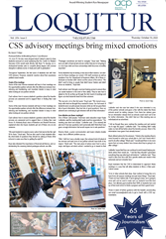 Shane Evans
Shane EvansSitting surrounded by textbooks and scattered papers on a late weeknight while cramming for the latest physical chemistry exam, Karen Randazzo, a senior chemistry and secondary education major, is exhausted. The work is piled high for Randazzo and the endless hours of studying are just the beginning of her work.
Randazzo said, “It’s one of the hardest things I’ve ever done in my life.”
Nationwide, finding science majors like Randazzo is becoming a rarity. At the college level, America is faced with two problems in science education. The first issue science education is dealing with is that too few Americans are performing at the highest level in science compared with the competitors abroad.
The second issue science education bumps into is the aspiring science majors who are turned off by unimaginative teaching at the college level. As many as half of the aspiring science majors leave the field of science and migrate to other fields, according to the New York Times.
Randazzo is one of the few who have remained in the science field. This year, Randazzo will be the only chemistry major to graduate in May. Also, Randazzo is the first chemistry and secondary education major in nine years.
“You have to be really dedicated,” she said.
Randazzo must take up to 55 credits in her field. As part of the core curriculum, science classes are a requirement. The requirement includes one lab that is counted as one credit. Also, two other science classes must be taken for six credits. One of the two science courses must correspond with the lab. Dr. Charlie McCormick, dean for academic affairs, explained the importance of the science classes being included within the core requirements.
McCormick said, “Learning the scientific method is important. It’s transferable to all sorts of areas.” McCormick also explained that globally, it is necessary to be able to cross-culturally communicate.
Although Randazzo has managed to remain in her field, the other students who are turned off by the intensity of the science programs and their presentation could be inspired by future programs. The University of Maryland, Baltimore County, has given their science program a new spin to get students more involved and interested. The New York Times reported that U.M.B.C.’s Meyerhoff Scholars Program receives about 1,900 nominees a year for their program, mostly from Maryland, for merit-based scholarships. About 100 scholarships are offered, and of these about 50 are accepted. After the students enter the program, they work side-by-side and with scientists-to-be for the next four years setting up the stage for their college career.
Dr. Kimberly Boyd, associate professor of biology, explained that students venture into other fields for several reasons. Boyd explained that many students come into the program unprepared and not understanding the academic component.
Boyd said, “It’s a rigorous program. It’s hard when you get here.”
Boyd also explained that students who are not used to receiving below an “A” as a grade are shocked with the average grade of a “C” in their introductory science courses. Randazzo spends two hours studying for every hour she spends in class. Previously, Randazzo used to study three hours for every hour she spent in class.
Randazzo said, “Oh God. There’s a lot of time and effort.”
Boyd as well as other science professors, teach college success seminars. During the course, many students drop out.
Boyd said, “Most people self-select out early.”
Boyd also explained to get more students involved in the field, the science department is also creating work shop classes like at U.M.B.C. for science majors. The New York Times reported that the U.M.B.C. program tries to encourage the students by having them study in groups and also it has the students work together in solving complex problems, as teams of scientists do.
An example of the hand-on experience Boyd described is the forensic science class offered all year. The class is a workshop with a lecture incorporated into the hands-on work.
Boyd said, “You’re totally engaged the whole time.”
Although Randazzo is one of the few graduating from the field of science this year, the total number of science majors in fall 2005 was 127, up from 71 in fall 2002. Of the entering class of 71, five graduated in 2006. This low graduation number is somewhat deceptive, however. The science department has students who are enrolled in pre-professional programs such as pre-nursing and pre-pharmacy. These students do finish their program; however, they are not awarded a degree here but transfer to other universities to finish their degree. Also, the number of science majors does not include the exercise science and health promotion major, according to the office of the registrar.
The road to graduation for science majors is challenging for many, yet Randazzo is nearing the completion of a successful college career.
She said, “I got this far I can’t stop now.”


